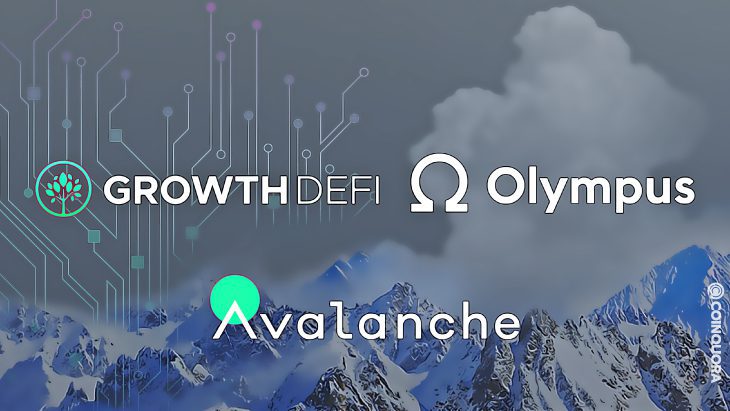- Growth DeFi partners with OlympusDAO to be a key player in Avalanche’s inaugural cohort.
- Growth DeFi has released its new hybrid bridge mechanism for its incentives token $WHEAT.
- $WHEAT can be farm by staking GRO, MOR, or WHEAT.
Growth DeFi, — An innovative DeFi cross-chain farming protocol, has announced its fantastic partnership with OlympusDAO to join the first Olympus Pro Avalanche Cohort.
On November 13, Growth DeFi released its groundbreaking hybrid bridge, a new mechanism for its incentives token, $WHEAT. Additionally, the Growth DeFi platform’s overcollateralized stablecoin, $MOR on Avalanche to provide benefits from the new hybrid bridge architecture that aligns incentives between WHEAT holders on different chains.
To clarify, $WHEAT is an incentive token in the Growth DeFi ecosystem that can be generated by staking GRO, MOR, or WHEAT. The WHEAT hybrid bridge exists to improve cross-chain DeFi. According to Growth DeFi, the WHEAT hybrid bridge will benefit Growth DeFi’s stakeholders and WHEAT holders.
Moreover, the WHEAT hybrid bridge is an important feature that adds value toWHEAT holders. The protocol allows supply reduction through arbitrage and gives exceptionally high APYs on the Avalanche chain.
On one side, the hybrid bridge protocol will be funded by 10% of Avalanche’s daily emissions which will include price changes in the Binance Smart Chain (BSC). In doing this, the Avalanche ecosystem will be updated regularly on time.
All of the Growth DeFi ecosystem characteristics, including the newly implemented hybrid bridge and the feature of self-repaying loans for MOR and xJOE leverage farming, are on the Avalanche chain.
Furthermore, MOR functions as Growth DeFi’s overcollateralized stablecoin that enable users to earn yield. Through this, users can borrow and leverage yield farming positions for LPs and single assets. At the same time,GRO is the governance token of Growth DeFi and has ownership of the surplus generated by MOR.
In addition, MOR converts high-performance fees earned on yield to USDC.e, injected into a secondary Peg-Stability Module (PSM), which converts the high-performance fees collected in USDC.e back to MOR.
What is more, the self-repaying approach also contributes to MOR’s status as a stablecoin. It does this by producing a daily flow of USDC.e into the PSM, thus, making the borrowing and redeeming MOR much easier for users.
The Growth ecosystem’s partnership with OlympusDAO resulted in the addition of three bonds to the Olympus Avalanche Cohort:
GRO/MOR TraderJoe LP Tokens
Users will exchange their LP tokens for the Growth DeFi governance token, GRO. The surplus earned by MOR, the overcollateralized stablecoin now backed on Avalanche by xJOE, TraderJoe LP tokens, and jTokens, is distributed to the governance tokens (deposits on BankerJoe). Notably, there is $1.85 of collateral backing every MOR in circulation.
The GRO/MOR bond would aid in providing GRO liquidity; the bond would be allocated 20,000 GRO monthly.
WHEAT/MOR TraderJoe LP Tokens
Users will exchange WHEAT/MOR LP tokens for WHEAT, the Growth DeFi incentive token. In addition, Olympus Pro bonds will aid in the purchase of various yield accruing tokens, increasing the value of WHEAT’s treasury and backing per token. 70% of the 25,000 WHEAT set aside for bonds will be distributed in the first month.
MOR/AVAX TraderJoe LP Tokens
Users will exchange their MOR/AVAX LP tokens for AVAX. MOR must be able to be swapped directly for other assets on the network to improve liquidity and make it tradeable.
In addition to the MOR/AVAX bond, Growth DeFi intends to offer MOR swaps with major assets such as BTC, ETH, and gOHM. The first month will see the allocation of 30% of the 11,000 WHEAT earmarked for bonds.
The purpose of these bonds is to allow the Growth Ecosystem to own its liquidity and stop relying on external LPs to provide liquidity. As a result, the bonds would enhance the amount of MOR in circulation while also providing greater liquidity depth for purchasing and selling GRO and WHEAT.
In addition, the bonds will also enable the ecosystem to earn additional income from swap fees and always supply liquidity regardless of market conditions.
The partnership with OlympusDao would assist the Growth ecosystem in integrating the vibrant ‘ohmie’ community into its ecosystem. OlympusDAO, which has done over $800 million in bond volume, understands bond configuration and Growth DeFi may leverage that knowledge to its advantage.
The introduction of bonds and the collaboration with OlymousDAO appear to have positioned Growth DeFi as an ecosystem, offering more value and changing the way DeFi works as a whole.


